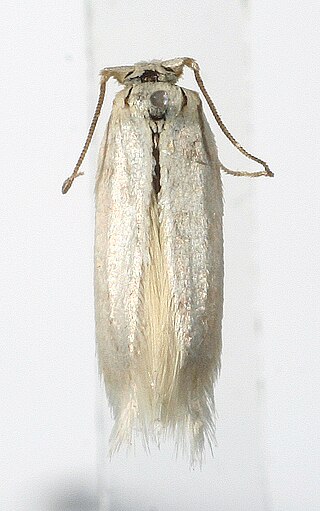
Nepticulidae is a family of very small moths with a worldwide distribution. They are characterised by eyecaps over the eyes. These pigmy moths or midget moths, as they are commonly known, include the smallest of all living moths, with a wingspan that can be as little as 3 mm in the case of the European pigmy sorrel moth, but more usually 3.5–10 mm. The wings of adult moths are narrow and lanceolate, sometimes with metallic markings, and with the venation very simplified compared to most other moths.

Opostegidae or "white eyecap moths" is a family of insects in the order Lepidoptera that is characterised by particularly large eyecaps over the compound eyes. Opostegidae are most diverse in the New World tropics.
Eosopostega issikii is a species of moth of the family Opostegidae. It is known only from the Izu Peninsula in south-central Honshu and from Kagoshima at the south-western tip of Kyushu.
Neopostega asymmetra is a moth of the family Opostegidae. It is known only from the type locality, in the Atlantic coastal forest in southern Brazil.
Neopostega petila is a moth of the family Opostegidae. It is known only from a lowland rainforest in north-eastern Costa Rica.
Pseudopostega denticulata is a moth of the family Opostegidae. It is only known from eastern and western Ecuador.
Pseudopostega chalcopepla is a moth of the family Opostegidae. It is known from southern France, Monaco and the Iberian Peninsula, as well as Morocco and Tunisia. It is only found in the coastal region.
Opostega afghani is a moth of the family Opostegidae. It was described by Donald R. Davis in 1989. It is known from Afghanistan.
Opostegoides malaysiensis is a moth of the family Opostegidae. It was described by Donald R. Davis in 1989. It is known from western Malaysia.

Pseudopostega cretea is a species of moth in the family Opostegidae. It was first described by Edward Meyrick in 1920. It is known from the eastern half of North America from southern Canada south to northern Florida, west to south-eastern British Columbia and Texas.
Pseudopostega monosperma is a moth of the family Opostegidae. It was described by Edward Meyrick in 1931. It is known from Bahia, Brazil.
Pseudopostega perdigna is a moth of the family Opostegidae. It was described by Walsingham, Lord Thomas de Grey, in 1914. It is known from Guerrero, Mexico.
Pseudopostega pontifex is a moth of the family Opostegidae. It was described by Edward Meyrick in 1915. It is known from Cali, Colombia.
Pseudopostega quadristrigella is a moth of the family Opostegidae. It was described by Frey and Boll in 1876. It is known from Maine west to South Dakota and south to Texas.
Pseudopostega acrodicra is a moth of the family Opostegidae. It was described by Donald R. Davis and Jonas R. Stonis, 2007. It is known from south-central Brazil.
Pseudopostega bicornuta is a moth of the family Opostegidae. It was described by Donald R. Davis and Jonas R. Stonis, 2007. It is known from southern Mexico.
Pseudopostega clavata is a moth of the family Opostegidae. It was described by Donald R. Davis and Jonas R. Stonis, 2007. It is known from south-eastern Puerto Rico.
Pseudopostega lobata is a moth of the family Opostegidae. It was described by Donald R. Davis and Jonas R. Stonis, 2007. It is probably a common, widespread neotropical species, now reported in Central America from Belize to Costa Rica, with two records from northern Argentina.
Pseudopostega texana is a moth of the family Opostegidae. It was described by Donald R. Davis and Jonas R. Stonis, 2007. It is known from the Rio Grande Valley of southern Texas, probably south into Mexico.
Pseudopostega robusta is a moth of the family Opostegidae. It was described by Andrius Remeikis and Jonas R. Stonis in 2009. It is known from the Pacific Coast of Costa Rica.
This page is based on this
Wikipedia article Text is available under the
CC BY-SA 4.0 license; additional terms may apply.
Images, videos and audio are available under their respective licenses.


